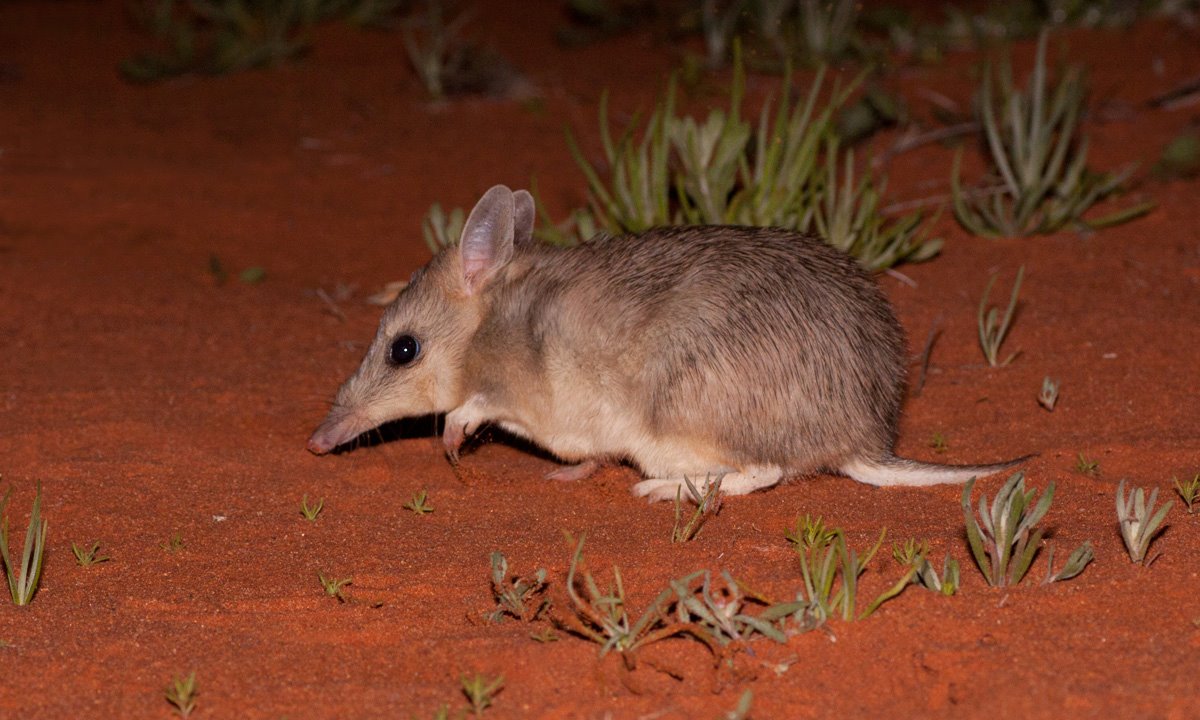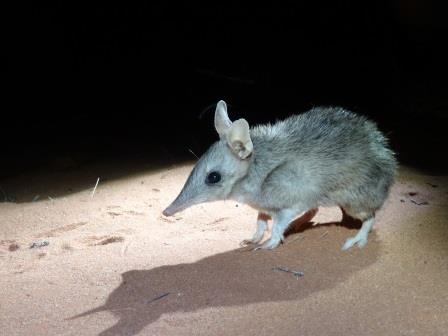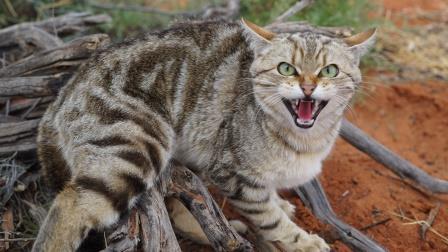The end of the Western Barred Bandicoot?
Katherine Tuft
08 March 2018

Don’t worry, it’s not extinct, but a new study by the WA Museum says that the Western Barred Bandicoot isn’t who we thought it was.
Western Barred Bandicoots (Perameles bougainville) once lived over much of southern arid Australia, from Western Australia to New South Wales and Victoria. By the 1930’s, they were extinct on the mainland, largely due to predation by feral cats and foxes. They only survived on two islands (Bernier and Dorre), off the Western Australian coast and are currently listed as Vulnerable to extinction. They have been reintroduced to three predator-free sites: here at Arid Recovery, and Faure Island and Mt Gibson Wildlife Sanctuaries in Western Australia, and there are plans for reintroduction of Western Barred Bandicoots to sites in NSW in the near future. The Western Barred Bandicoot’s former range. Source: Western Barred Bandicoot Perameles bougainville, Burrowing Bettong Bettongia lesueur and Banded Hare-Wallaby Lagostrophus fasciatus National Recovery Plan (2012).This new study looked at the morphometrics and genetics of museum specimens and concluded that what has been known as the “Western Barred Bandicoot” is in fact five different species. All five were very closely related, and four are now extinct. One of these recently extinct species is the delightfully named Perameles papillon or Butterfly Bandicoot. The only surviving species occurred in the far north-west of the country and is the species which has been used for reintroductions back onto the mainland.
The Western Barred Bandicoot’s former range. Source: Western Barred Bandicoot Perameles bougainville, Burrowing Bettong Bettongia lesueur and Banded Hare-Wallaby Lagostrophus fasciatus National Recovery Plan (2012).This new study looked at the morphometrics and genetics of museum specimens and concluded that what has been known as the “Western Barred Bandicoot” is in fact five different species. All five were very closely related, and four are now extinct. One of these recently extinct species is the delightfully named Perameles papillon or Butterfly Bandicoot. The only surviving species occurred in the far north-west of the country and is the species which has been used for reintroductions back onto the mainland.
 The only surviving species of Western Barred Bandicoot
The only surviving species of Western Barred Bandicoot
This means that their translocation to Arid Recovery was technically an ‘introduction’ rather than a ‘reintroduction’. Skulls of the now extinct bandicoot species from the region had larger auditory bullae than the other bandicoots. Auditory bullae are bulbous bony structures towards the back of the skull and are thought to amplify sounds. The extinct bandicoot might have had exceptional hearing, honed to detecting predators and prey in its arid environment, but we’ll probably never know.
Nonetheless, the bandicoots reintroduced into the Arid Recovery Reserve are thriving 17 years after their release. From 16 founders, we have a strong population of over 500 and are the only site with mixed genetics from both Bernier and Dorre islands. A recent study shows that not only have the genetics from both islands survived in our reserve, but the genetic diversity has actually increased.
The authors of this new bandicoot study question whether it is right to translocate the only remaining species of western barred bandicoot into areas formerly inhabited by extinct sister-species. In a perfect world, we would have the right bandicoot in the right place, but the Australian landscape has changed dramatically since the original five species of western barred bandicoot skipped and dug their way around the vast outback. Four of those species are completely gone, never to return. Many of their sympatric species of medium sized mammals have disappeared as well, some to last refuges on islands and others lost to history. In their places are hordes of rabbits, and with them feral cats and foxes.
 Feral cats pose a significant threat to bandicoots
Feral cats pose a significant threat to bandicoots
Busy digging bandicoots perform important functions in the ecosystem, turning over the soil, sequestering carbon and nitrogen, and creating constellations of little compost pits across the desert that facilitate the germination of native plants. This is exactly what bandicoots are busy doing at Arid Recovery. Whatever adaptations this West Australian bandicoot might be lacking for desert life does not appear to affect their long-term survival here. Surely it is better to have the ‘wrong’ bandicoot than no bandicoot at all.
 Western Barred Bandicoot being released
Western Barred Bandicoot being released
There are cases where moving and mixing groups of animals has been critical for saving species. Mountain pygmy possums foundered for years in remnant populations separated by miles and miles of country. In earlier years, managers took care to retain the unique genetic make-up of each population, on the assumption that animals in each population were especially adapted to the particular conditions at each site. Enormous efforts went into captive breeding, but still the possums failed to thrive. It was later identified that the main failure of the population to increase was due to inbreeding. In a short space of time, with some swapping of animals between populations, the possums are finally breeding well and their future is looking less bleak. You can learn more about this genetic rescue effort in this Conservation article, or watch the Catalyst episode.
I spent my earlier career working with brush-tailed rock-wallabies and continue to pay attention to the efforts to improve the outlook for these fantastically nimble animals. Genetic comparisons of brush-tailed rock-wallaby populations identified three distinct groups (called Evolutionarily Significant Units). Defining a subspecies as distinct from a species or some developing latent subspecies is somewhat subjective and rather fraught. These three groups are considered somewhere below the level of subspecies. And here’s where politics came in. One of the ESUs occurrs solely in Victoria. It did not cross the border into NSW. State legislation, armed as it should be to identify and protect endangered species, classified the Victorian rock-wallabies as Critically Endangered. Large sums of money and years of effort by many talented people were invested in saving the Victorian brush-tailed rock-wallaby. Some of the last remaining individuals were taken from the wild and brought into a captive breeding program. Pouch young were cross fostered onto mother wallabies from other genera (Tammar wallabies) to fast-track the breeding program. And precious new animals were returned to the wild. Despite these herculean efforts, the rock-wallabies failed to do well, there was little successful wild breeding, and various unfortunate misadventures took a toll. In desperation, the Victorian rock-wallabies are now being mixed with rock-wallabies from NSW and the outlook for the species in Victoria is improving.
 Brush-tailed rock wallaby
Brush-tailed rock wallaby
Australian ecosystems are dramatically different now compared to 200 years ago, and will stay that way until feral animals can be fully eradicated. In this much altered landscape, I think it is counterproductive to be too precious about retaining the nuances of genetic variation or restoring landscapes to exactly how they were (or how we think they might have been). I believe we need to accept the state of things for now, and work with what we have. If an equivalent species can perform a similar function in the landscape, it’s better than leaving that role vacant. A slightly different little bandicoot digging around in the red sand is surely better than the gaping absence left by the original bandicoot’s extinction.